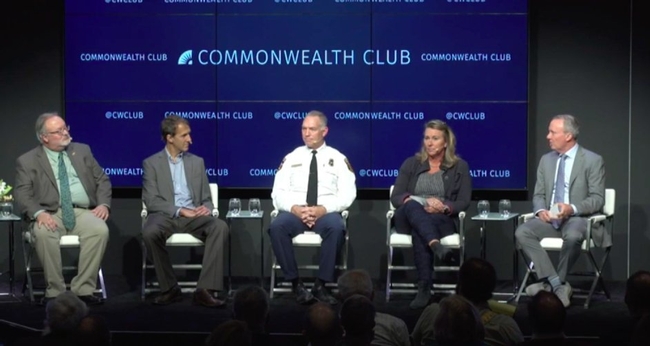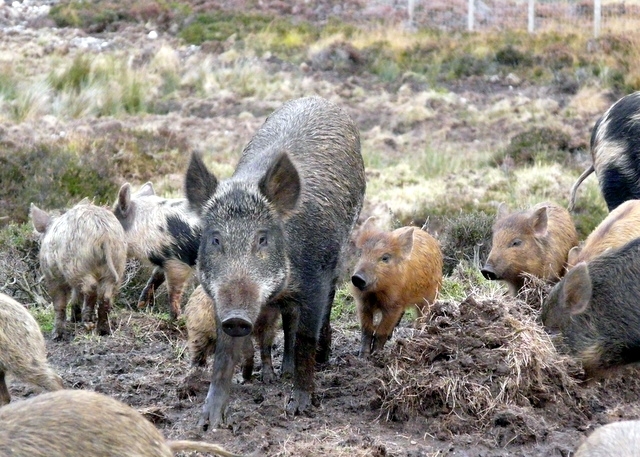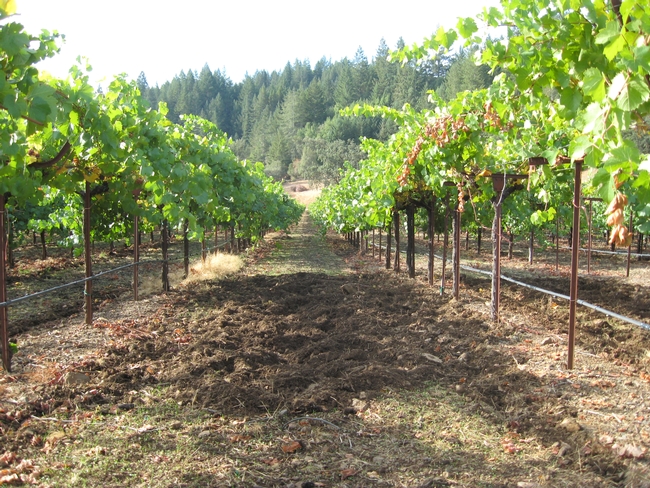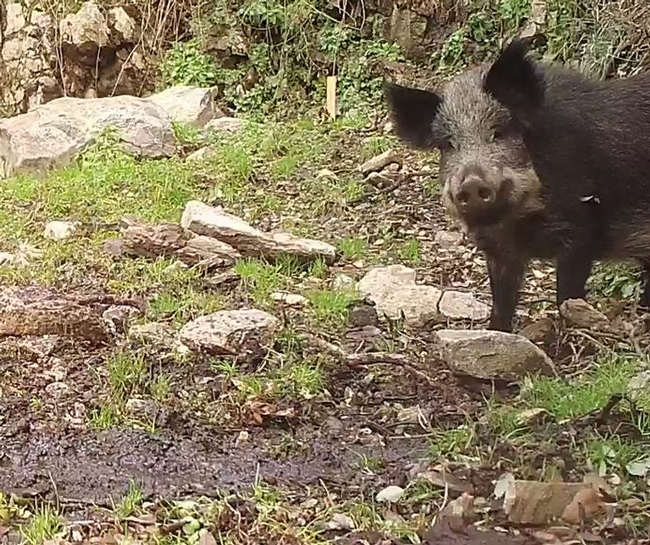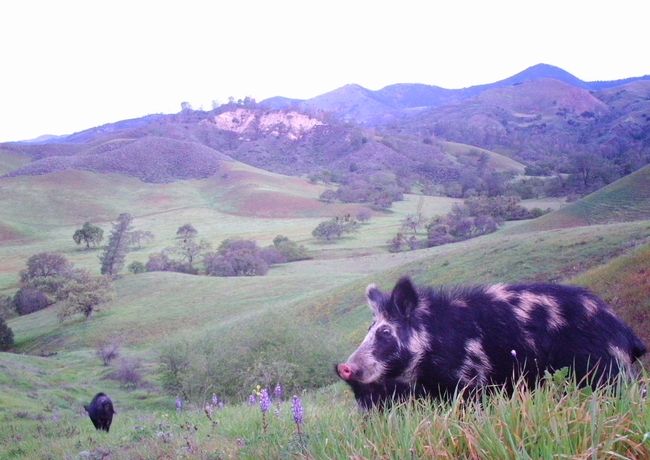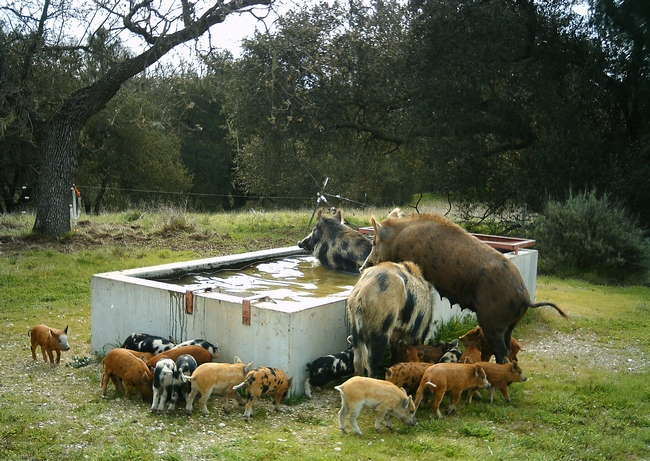Posts Tagged: John Harper
December news clips
Franz Niederholzer - 2019 New Year's Profile
(Appeal-Democrat), Dec 31
Keeping Up with Navel Infections
(Dairy Herd Management) Emre Gürdal and Noelia Silva del Rio, Dec. 31
How Do Wildfires Start?
(Live Science) Donavyn Coffey, Dec. 28
…In other words, "a source [of heat] hits receptive fuel that's dry enough to burn," said Lenya Quinn-Davidson, a fire analyst for the University of California Cooperative Extension forestry program in Northern California. In the right conditions, those three factors are all it takes to set a wildfire in motion.
…However, ignition is only the beginning. For a spark to grow into a sustained wildfire, there must be a perfect combination of factors, such as "dry conditions and really strong winds," Quinn-Davidson told Live Science. And because of climate change, dry conditions are lasting longer and, in turn, causing longer fire seasons.
https://www.livescience.com/64378-how-do-wildfires-start.html
Analyzing The Use of Selective Dry Cow Therapy
(Dairy Herd Management) Fernanda C. Ferreira and Emmanuel Okello, Dec 27
Private woodlands lost to California wildfire — and may not be replaced
(SF Chronicle) Peter Fimrite Dec. 25,
…It costs about $400 per acre to reforest land, said Bill Stewart, a forestry specialist at UC Berkeley who has studied forest restoration programs after fires.
“A lot of (small property owners) ... don't have the cash or professionals to do the job,” he said. They “take a big financial hit when their forests are caught in a wildfire.”
…Max Moritz, a wildfire specialist at the University of California Cooperative Extension, said wholesale clearing is not always necessary. The rush to clear the land, he said, can result in healthy trees being cut down.
“Many trees can survive pretty bad crown scorch, so there's generally no urgency to get them out, or there shouldn't be, anyway,” said Moritz, an adjunct professor at UC Santa Barbara. “This is especially true of species that resprout, like several of the oaks and also redwoods.”
Get to know your wasps: University of California entomologist addresses misconceptions
(Press Democrat) Kate Frey, Dec. 21
Rachael Long, a University of California Cooperative Extension entomologist and crop adviser, recently told me a story about three wasps that people frequently encounter around their homes and often have misconceptions about.
https://www.pressdemocrat.com/lifestyle/9077426-181/get-to-know-your-wasps
Gene Editing Finds its Way to the Farm
(Dairy Herd Management) Clinton Griffiths, Dec. 21
…Alison Van Eenennaam, animal geneticist, University of California-Davis, says edits that create polled herds will soon be common.
“It's kind of like a pair of molecular scissors, if you will, that you can tell to go and cut the DNA at a very precise location in the genome,” Van Eenennaam explains. “What that enables you to do is go in and very precisely alter one particular gene of the thousands of genes that make up the genome, and you can introduce useful genetic variations.”
https://www.dairyherd.com/article/gene-editing-finds-its-way-farm
Farm Bill Set to Bring Several Benefits to California Growers
(AgNet West) Brian German, Dec. 19
...“There's some really good stuff in it for California, I mean first of all, getting a farm bill is fantastic,” said Vice President of UC Agriculture and Natural Resources Glenda Humiston. “Some really good things for beginning farmers and ranchers, and veterans' efforts in ag. One thing that's really potentially exciting for California in the rural development title is increasing the eligibility of communities up to 50,000 for some of the programs.”
http://agnetwest.com/farm-bill-benefits-california-growers
Gene-edited farm animals are coming. Will we eat them?
(Washington Post) Carolyn Y. Johnson, Dec. 17
...“Right now. This is exciting, right this minute,” animal geneticist Alison Van Eenennaam said as she waited for a tiny blob of a fetus to materialize on a laptop screen on a recent afternoon at the Beef Barn, part of the University of California at Davis's sprawling agricultural facilities for teaching and research.
Commentary: Is Atascadero prepared?
(Atascadero News) Ray Weymann, Dec. 14
…But often, even 10 feet from a house takes one into a neighbor's property. Whether this means mandating more aggressive tree and brush clearing, and reevaluation of building codes for new and existing structures, is something the new council should consider, availing themselves with input from our local fire department but also from people like Jack Cohen. Another wildfire expert, Max Moritz, suggests that governments must be more aggressive in not allowing development in areas especially vulnerable to wildfire.
https://atascaderonews.com/article/commentary-is-atascadero-prepared
Ceres Imaging unveils cumulative stress index
(Successful Farming) Laurie Bedord, Dec. 14
...“Findings over the last four years show that the average Ceres Imaging conductance measurement from its imagery over the season has provided the best correlation with applied water,” says Blake Sanden, a Kern County University of California Cooperative Extension farm adviser. “While there's no perfect predictor of final yield, Ceres Imaging aerial sensing of canopy plant stress has a significant relationship with final yield.”
https://www.agriculture.com/news/technology/ceres-imaging-unveils-cumulative-stress-index
New Farm Bill Provides Funds For Research In California ‘Ag,' But No Big Boons
(Capital Public Radio) Julia Mitric, Dec. 13
…"What's fascinating about the Farm Bill is, after all that hyper-partisan debate … it's really a lot of the same of what we already had," said Glenda Humiston, vice president of University of California Agriculture and Natural Resources.
Humiston is pleased that California will get an increase of $25 million a year for research of specialty crops, agricultural jargon for fruits, vegetables and nuts, as opposed to commodity crops like soybeans, corn and wheat. Those federal grants will cover many areas, from adapting farming to the effects of climate change to finding cures for California's many invasive pests, Humiston said.
Can California Improve Forest Management And Prevent Wildfires Without Going Broke?
(Capital Public Radio) Ezra Romero, Dec. 13
...But can California expand programs like forest-thinning and controlled burns and manage its forests on the cheap?
UC Berkeley forestry specialist Bill Stewart says yes. “There's certain areas that it is going to cost you $700 an acre, but other acres you can treat for $50 or $100 an acre,” Stewart said.
Technology advances impact production efficiency
(AgriNews) Martha Blum, Dec. 13
“I'm passionate about genetics and sticking up for technology because if we don't stand up for it, we're not going to have access to it,” said Alison Van Eenennaam, Cooperative Extension specialist in the Department of Animal Science at University of California, Davis.
“The livestock industry doesn't have access to GMOs because of the debate around plant GMOs,” Van Eenennaam said during a presentation at the 2018 American Agri-Women Convention.
Lindcove squeezes 100 citrus varieties into one tasting
(Sun Gazette) Dec. 12
The University of California citrus research center swings open its doors this week to give farmers and the public the opportunity to view and taste more than 100 varieties of citrus.
Can Rakes Save Forests? Yes, As Long As You Have A Drip Torch In The Other Hand, UC ANR Says
(Sierra Sun-Times) Susie Kocher, Rob York, and Lenya Quinn-Davidson, Dec. 12
Have shears, will travel
(California Bountiful) Ching Lee
…Sheep owners, particularly those with small flocks, have had trouble finding shearers for years—and the smaller their flock, the harder it is to get someone to shear for them because shearers are paid by the number of animals they shear, said John Harper, a UC livestock and natural resources advisor who has run the annual shearing program for nearly 25 years.
http://www.californiabountiful.com/features/article.aspx?arID=2199
Could legalizing cannabis help the environment?
(Physics World) Kate Ravilious, Dec. 11
Using high resolution satellite imagery for the years 2012 and 2016, Van Butsic from the University of California, Berkeley and his colleagues found a boom in cultivation of cannabis in Mendocino and Humboldt Counties. By zooming right in, the researchers could identify the distinctive shape of the cannabis plants, the regular pattern in which the crop is planted, and the greenhouses perched in unusual places.
...“The chances of environmental damage are much greater in these regions because of the high potential for erosion, which threatens water quality, high potential for using water directly from headwaters, and the need to build roads to access these farms,” says Butsic.
https://physicsworld.com/a/could-legalizing-cannabis-help-the-environment/
What Does It Take To Defend Your Home Against A Mega Wildfire Like The Camp Fire? Here's How One Couple Survived
(Capital Public Radio) Ezra David Romero, Dec. 11
...Earlier this year, University of California system forest advisor Yana Valachovic toured the Carr Fire burn area in Redding.
“What surprised me there was how many of the stucco homes were lost and they were surrounded by green lawn,” Valachovic recalled. “What the mechanism of entry was is that they had a ring of vegetation right around the outside of their house.”
Susie Kocher, a forest adviser for the Lake Tahoe region with the UC Cooperative Extension, often works with homeowners that live within the Angora Fire burn area. That blaze destroyed about 250 homes in Lake Tahoe in 2008. A decade later, Kocher said people still aren't properly preparing their homes.
“There's still a lot of flammable plants planted right under picture windows,” Kocher said, adding that people have almost set themselves up for failure, “perhaps in the mistaken belief that they are kind of safe now because there's no big trees.”
https://www.kpbs.org/news/2018/dec/11/what-does-it-take-defend-your-home-against-mega-wi
Wildfire scientists brace for hotter, more flammable future as Paradise lies in ashes
(CNN) Bill Weir, Dec. 10
…"Well, my colleague Katharine Hayhoe says climate change is like gravity," says Dr. Faith Kearns. "Climate change doesn't really care if you believe in it or not. It's reality. We have gravity, we have climate change."
https://www.cnn.com/2018/12/10/us/california-wildfires-climate-weir-wxc/index.html
Are Your Bananas at Risk?
(BYU Radio) Top of Mind, Dec. 10
Guest: Norman C. Ellstrand, Distinguished Professor of Genetics, Department of Botany and Plant Sciences, University of California, Riverside
...Here in the US, there's only one kind of banana in the supermarket – sweet, yellow, no seeds, about as long as your hand. It's a variety called Cavendish and it dominates the international banana market. Which turns out to be a big problem.
Jeff Mitchell: Conservation No-Till Is One Option For Water Conservation
(Cal Ag Today) Patrick Cavanaugh, Dec. 10
Jeff Mitchell is a Cropping Systems Specialist at UC Davis, based at the Kearney Agricultural Research and Extension Center in Parlier. He has devoted his 19 years to improving nitrogen and water use efficiencies in food, feed, fuel and fiber in no-till cropping systems.
https://californiaagtoday.com/jeff-mitchell-conservation-no-till-one-option-water-conservation/
Solano 4-H schedules Fairfield open house
(Fairfield Daily Republic) Susan Hiland, Dec. 9
The Solano County 4-H Youth Development Program will host a 4-H open house from 5:30 to 8:30 p.m. Wednesday on the first floor of the University of California Cooperative Extension Office, 501 Texas St.
California State Fair Extra Virgin Olive Oil Competition opens Jan. 8
(Lake Co News) Dec. 8
…The California State Fair is proud to announce the head judge for the 2019 competition, Mr. Paul Vossen. Vossen will employ his expertise and experience at the California State Fair olive oil judging to lead the team of 15 Judges and ensure a fair and ethical judging process.
With more than 30 years of experience in the field as a University of California Cooperative Extension Farm Advisor in Sonoma County, Paul Vossen offers practical advice to large commercial ventures and hobby farmers alike for clients around the world.
Getting the Facts Straight on Dairies
(California Dairy) Dec. 7
The inaugural California Dairy Sustainability Summit in Sacramento last month was a big hit. Conference presentations not only focused on what California dairy producers can do to increase their sustainability efforts, but also on how producers can better share their stories and correct some of the common misconceptions that have been circulating the public. Check out this video with Frank Mitloehner, Air Quality Specialist from the Department of Animal Science at UC Davis, who shared the facts, and read more about it in California Dairy Magazine.
http://www.californiadairymagazine.com/2018/12/07/getting-the-facts-straight-on-dairies
Why Californians Were Drawn Toward the Fire Zones
(Wall St Journal) Jeffrey Ball, Dec. 7
…Lax building codes are at the base of the problem. Even in California, which has some of the toughest such rules in the country, they often aren't adequate or adequately enforced. The codes often dictate the use of fire-retardant materials in house construction but typically say nothing about how a development must be situated on the landscape—and that can help determine whether that development will burn in a fire, says Max Moritz, a cooperative-extension wildfire specialist at the University of California, Santa Barbara. “So the developers are able to come in, propose something, and often, without too much oversight, walk away after having built something in a dangerous place,” he says. “And we pick up the tab.”
https://www.wsj.com/articles/why-californians-were-drawn-toward-the-fire-zones-1544202053?mod=e2tw
Cutting down Christmas trees on public land is good for forest management: expert
(KTVU) Lisa Fernandez, Dec. 7
A forestry advisor for the University of California is a big proponent of cutting down Christmas trees on public land as an inexpensive, family-friendly holiday ritual and a way to thin the forests of excessive small trees.
Susie Kocher, who works for the UC Cooperative Extension, has been trekking to the U.S. Forest Service land for the last two decades -- saw and $10 permit in hand -- to cut down her own white fir.
Researchers study how to enrich soil
(Appeal-Democrat) Ruby Larson, Dec. 6
Soil health and research on using cover crops were discussed by farmers, researchers and others at the University of California Cooperative Extension's Soil Health and Cover Crop Field Day on Thursday morning.
Dozens gathered for a presentation on the Healthy Soils Project, which the local UCCE is participating in. The project focuses on managing soil health, changes in soil carbon and reducing greenhouse gases.
…Amber Vinchesi and Sarah Light, agronomy adviser for UCCE Sutter-Yuba, gave a demonstration on how they would test for greenhouse gasses during the course of the project.
Climate Extremes: the New Norm
(Santa Barbara Independent) Laura Capps, Dec. 6
...“We need to change our perspective to one of co-existing with fire instead of fighting it,” said Dr. Max Moritz, a University of California wildfire scientist. “Fire isn't going away anytime soon. We need to locate and build our communities accordingly so that we reduce our vulnerability over the long term to this essential and inevitable natural process that is wildfire.”
https://www.independent.com/news/2018/dec/06/climate-extremes-new-norm
Will More Permits To Chop Down Christmas Trees Help Thin California Forests And Prevent Wildfires? (AUDIO)
(Capital Public Radio) Ezra David Romero, Dec 5
In a patch of forest a few miles from Lake Tahoe's shore, Susie Kocher and her family are crunching through the snow to find a Christmas tree.
…"It's a great win-win solution,” said Kocher, who is also a forest advisor for the University of California Cooperative Extension for the Lake Tahoe area. “You get the public out in the forest, you do good work reducing the density of the trees."
Wildland fire research and impacts on nut orchards
(Western Farm Press) Logan Hawkes, Dec 5
..So far, tree nut damages or other agricultural losses in the deadly Camp Fire are unknown according to UCANR Sustainable Orchard Farm Advisor Luke Milliron in Butte County.
https://www.farmprogress.com/tree-nuts/wildland-fire-research-and-impacts-nut-orchards
Fruit tree owners get free lesson in pruning
(The Californian) John Karlik, Dec 5
Even those with the greenest thumbs may need some guidance when it comes to pruning trees. The University of California Cooperative Extension office is here to help again with its annual fruit tree pruning demonstrations on Dec. 12 and 13.
Starting at noon both days in the orchard of the cooperative's office, ag adviser Mohammad Yaghmour will show attendees how to trim back trees including apple, apricot, cherry and almond as well as grapevines.
Camp Fire Impacted Local Prescribed Fire Training
(My Mother Lode) Tracey Petersen, Dec 5
...The 20 participants were to get hands-on fire experience to better understand the art and science of fire management and ecology. However, organizer and Natural Resources Advisor at the University of California Cooperative Extension – Central Sierra Susan Kocher relays that due to the explosion of the Camp Fire no flames could be ignited for the training because the required back up resources were called to battle the mega blaze. She adds it is an ongoing problem regarding using prescribed burns for fire prevention. “I really think it shows just our exact dilemma. It's hard to get ahead of disasters because you're busy responding to disasters,” advised Kocher. “So, we just need to do everything we can to try and burn at all times of year to try to get ahead of these tragic wildfires that are happening.”
The New Abnormal: A Town Hall on California's Fires and the Future
(Commonwealth Club) Dec. 4, 2018
… To address some of these critical and urgent questions, please join The Commonwealth Club for a special free town hall on California's fires and what can be done in the short and long term to prepare for them.
Guests:
J. Keith Gilless, Chair, California Board of Forestry and Fire Protection; Professor of Forest Economics, UC Berkeley
Thom Porter, Chief of Strategic Planning, California Department of Forestry and Fire Protection (CAL FIRE)
Kurtis Alexander, Water, Wildfire and Climate Writer, San Francisco Chronicle
Maggi Kelly, Professor and Cooperative Extension Specialist in the Environmental Science, Policy and Management
Valley's Gold: Food Safety
(Valley's Gold) Dec. 4
Learn about the economic engine that drives the region, Agriculture. With host Ryan Jacobsen
UC CalFresh Nutrition Education Specialist Elizabeth Lopez shares food safety tips and tools in this PBS episode starting at the 18:32 mark.
https://www.pbs.org/video/valleys-gold-food-safety-bqfgv4
San Diego County wants to build 10,000 new homes in fire-prone areas
(San Diego Union Tribune) Joshua Emerson Smith, Dec. 3
…What these building codes and other rules don't take into account is whether a particular project should be built at all, said Max Moritz, a cooperative extension specialist in wildfire at the Bren School at UC Santa Barbara.
“There's all these hazards that we use to guide our building and our zoning from floods to landslides, and fire is not one of them,” Moritz said.
“In the end, the taxpayer is left holding the bill for all this,” he added. “The developer may do a really good job at designing and convincing everybody that it's the right thing to do, but after they walk away, the public is left doing fuels maintenance for decades, and the public picks up the bill when there's a disaster.”
California is managing its forests — but is the president managing its federal lands?
(NBC News) James Rainey, Dec. 2
...Scott Stephens, a University of California, Berkeley professor of fire science, said the fire cataclysms of the last two years seem to have ended a long era of inattention.
“We will start to change the trajectory,” he said, “so we won't have tragedies like we had in Paradise.”
Subfreezing temperatures predicted for early Monday in Modesto area
(Modesto Bee) Deke Farrow, Dec. 2
...The University of California Cooperative Extension in Sacramento County offers more
May 2018 News Clips
Mien farmers get advice for growing strawberries in Yolo County
(Woodland Daily Democrat) ANR news release, May 31
Abnormal Weather Takes a Toll on California Olive Crop
(Ag Net West) Brian German, May 30
The late winter freeze caused significant issues for several different commodities throughout the state and has been especially problematic for the California olive crop. The fluctuating temperatures have created substantial concern among the industry as bloom looks to be far below normal levels.
“Overall we're a little on the pessimistic side. The bloom, on the whole, has been pretty poor, many orchards actually have a very light, to next to no bloom at all,” said Dani Lightle, Cooperative Extension Orchard Systems Advisor for Glenn County. “There's an orchard here or there that looks pretty good, but on the whole, it is a little bit dismal.”
http://agnetwest.com/weather-takes-toll-california-olive-crop/
How Avocados Define LA and the Secret to Making the Best Damn Avocado Toast
(LA Taco) Gab Chabran, May 29
…Eric Focht who is a staff research associate in the lab of Mary Lu Arpaia at UC Riverside through UC Agriculture and Natural Resources and the Department of Botany and Plant Sciences tells L.A. Taco that the recent avocado economy boom is “similar to what we see today with something like bitcoin.” He helps run a breeding program at UCR studying different avocados varieties, focusing mostly on Hass avocados but also looking at other less known versions of the popular fruit.
In short, he is working on breeding the perfect avocado that tastes great and is easier, faster, and less water-dependent to grow. This year is shaping out to be a good one for avocados, but this issue is always one to keep in mind.
Focht states that in the future, there will likely be more variety available in the mainstream marketplace. One varietal that Focht gets excited about is the Reed avocado which has now been popping up in places such as Whole Foods. It's known for its round, dinosaur egg shape and is about the size of a softball. It has a relatively large seed but the edible flesh is sometimes double or even triple that of a Haas that can make a lot more people happier per individual fruit.
http://www.lataco.com/how-avocados-define-l-a-and-the-secret-to-making-the-best-damn-avocado-toast/
Amazing graze
(Chico News & Review) Ashiah Scharaga, May 24
When drifting clouds dapple the sky and vibrant wildflowers—tickled pink buds, honey-hued petals and virent stems—awaken in the verdant fields of Table Mountain, explorers quicken their pace. They spot trickling streams and grazing cattle. Occasionally, they look straight down, turning anxious eyes to their mud-slicked heels—did they step in one of the fertile cow-pie mines littered across the landscape?
That may seem a nuisance, but it's a necessity. Tracy Schohr, a livestock and natural resources adviser for University of California Cooperative Extension, said the natural magic of the popular Butte County recreational spot is made possible because of a long-standing grazing program. “If cattle were not actually on Table Mountain Ecological Reserve,” she said, “essentially those invasive species would choke out those native plants, and they wouldn't be there.”
… In the past, grazing was misunderstood and primarily viewed as destructive, said Dave Daley, a fifth-generation Butte County cattleman and associate dean of Chico State's College of Agriculture. He credits changing perspectives to the development of grazing science, fueled by people such as Schohr and Kate Wilkin, a UC Cooperative Extension forestry, fire science and natural resource adviser for Butte, Yuba, Sutter and Nevada counties. (Schohr covers Butte, Plumas and Sierra counties.)
https://www.newsreview.com/chico/amazing-graze/content?oid=26315855
Sheep Shearing 101: Why Aspiring Shavers Flock to This California School
(KQED) Tiffany Camhi, May 23
…“We try to get the students shearing the first day because they make a lot of mistakes,” says John Harper, head of the UC Cooperative Extension Sheep Shearing School in Hopland.
Harper says if you can make the right moves with your feet, everything else falls into place.
“We're dancing instructors,” says Harper. “It's like 'Dancing With The Stars' on steroids, but with sheep.”
Around this time of year, hundreds of thousands of sheep in California need to have their wool shaved off. But Harper says there's a shortage of sheep shearers worldwide.
That's why he started the school in Hopland about 25 years ago.
Dan Macon of the California Wool Growers Association says the growing popularity of backyard flocks in California (usually just a handful of sheep) is adding to the demand for shearers, too.
“Infrastructure of the sheep industry is a key component,” says Macon. “Having people with that kind of skill and willingness to work hard is desperately needed.”
AUDIO: Hey, Salad Lovers: It's OK To Eat Romaine Lettuce Again
(NPR Morning Edition) Allison Aubrey, May 23
…After a big foodborne illness outbreak linked to baby spinach back in 2006, the leafy greens industry put in place a number of procedures to prevent contamination. "Prevention became the major focus after that outbreak," says Michele Jay-Russell, a food safety researcher at the University of California, Davis.
"They set up intensive testing protocols to monitor water quality," Jay-Russell says. The industry also agreed on standardized setbacks — or buffers — to separate growing fields from livestock operations, which can be a source of E.coli contamination. "You want a safe distance from where you're growing fresh produce and where you have concentrations of animals, like on a feedlot or dairy," she says.
Are avocados toast?
(Grist) Nathanael Johnson, May 22
…When Katherine Jarvis-Shean was a doctoral candidate researching the decline of cold winters a few years back, she thought more farmers should be freaking out. “I used to think, ‘Why aren't you guys more worried about this? It's going to be the end of the world.'”
After all, many fruit and nut trees require a good winter chill to bear fruit. But after spending a few years as an extension agent for the University of California — working directly with farmers and translating science into techniques they can apply on the land — she understands better. It comes down to this: Farmers have a ton of concerns, and the climate is just one of them.
“If you decide what to plant based on climate, but then can't make the lease payment, that's not sustainable,” Jarvis-Shean said.
https://grist.org/article/whatll-we-eat-in-2050-california-farmers-are-placing-bets/ https://www.wired.com/story/are-avocados-toast/
Lanternflies Eat Everything in Sight. The U.S. Is Looking Delicious.
(New York Times) Zach Montague, May 21
…Native to Asia, lanternflies first appeared in Pennsylvania in 2014. Despite a quarantine effort, they have also been discovered in small numbers in New York, Delaware and Virginia.
… “Most pests deposit their eggs on their host plant, or very close, so they already have food available,” said Surendra Dara, an adviser at the University of California Cooperative Extension.
“Those that have the advantage of being able to lay eggs on non-plant material obviously have a better chance of surviving and spreading,” he added.
https://www.nytimes.com/2018/05/21/science/lanternflies-pennsylvania-crops.html
Garbanzos are catching on in Yolo County
(Woodland Daily Democrat, Ag Alert) Bob Johnson, May 19
…“The largest part of our crop goes to canning, maybe 90 percent,” said Paul Gepts, UC Davis plant sciences professor and legume breeder. “California can only compete with high quality products. We have other varieties with higher yields, but the seeds are too small. The growers get a premium for larger, high quality seeds.”
Gepts developed the two newest UC garbanzo varieties, Vega and Pegasus. Both have large, attractive seeds well suited for the canning market, and both have resistance to Ascochyta blight, a fungal disease that can devastate the crop.
… “I think growers are more interested in garbanzos because it's a winter crop, and wheat prices are low,” said Rachael Long, UC Cooperative Extension farm adviser in Sacramento, Solano and Yolo counties. Long is finishing up UC's first Garbanzo Production Manual, which should be available before the end of the year.
http://www.dailydemocrat.com/article/NI/20180519/NEWS/180519787
A French Broom smack-down
(Napa Valley Register) Elaine de Man, May 18
…If we all pull together and pay attention, we can eradicate French broom and send it packing. But it's going to take many, many hands and a concerted effort. It's going to take a village.
1. U.C. Agriculture and Natural Resources, Statewide Integrated Pest Management Program, http://ipm.ucanr.edu/PMG/PESTNOTES/pn74147.html
Kale, Not Jail: Urban Farming Nonprofit Helps Ex-Cons Re-enter Society
(New York Times) Patricia Leigh Brown, May 17
Even by the standards of the Bay Area, where sourcing local, organic chicken feed is seen as something of a political act, the spectacle of 30,000 fruit and nut trees being tended by formerly incarcerated orchardists is novel.
…Jennifer Sowerwine, an urban agriculture specialist for the University of California Cooperative Extension at Berkeley, said that Ms. Haleh and Mr. Raders have “shifted the conversation around food justice.”
“It's not just about food security, but the security of providing living wages,” she said. That's no mean feat in a foodie monoculture.
https://www.nytimes.com/2018/05/17/business/urban-farming-exconvicts-recidivism.html
Tough winter weather devastates local cherry, blueberry crops
(Bakersfield Californian) John Cox, May 16
It's hard to say at this point just how much damage blueberry fields and cherry orchards sustained during the winter, said Ashraf El-kereamy, viticulture and small fruits advisor with the University of California Cooperative Extension in Kern County.
Machines take over for people at Napa vineyard
(Capital Press) Tim Hearden, May 14
In the heart of the Napa Valley, a vineyard produces fine Cabernet Sauvignon with virtually no help from laborers.
The 40-acre “touchless vineyard” was established by Kaan Kurtural, a University of California Cooperative Extension specialist who has devoted much of his career to improving production efficiency in vineyards as labor shortages have worsened.
…When Kurtural started experimenting with vineyard automation 10 years ago, his primary goal was to save growers money in labor costs, he said. But since then, research has shown that grape quality is superior, largely because the tall canopy protects grapes from sun damage, he said. The system also uses less water than others, he said.
Dozens of strawberry growers gather in Santa Maria to learn latest industry advancements
(KSBY Staff) May 9
More than 100 farmers and growers took park in a meeting teaching them on the best way to grow a healthy strawberry.
The University of California put on the annual event which was free to the public.
Growers discussed improvements handling weeds, disease, and insects.
The Santa Maria Valley is the second largest strawberry growing area in California after the Salinas Valley.
The crop means a lot to people in Santa Maria.
"We've got a number of challenges to the California strawberry industry and we're doing are best to work together," said Steven Fennimore of University of California Cooperative Extension Agriculture and Natural Resources. "I'm optimistic that we'll find some satisfactory solutions."
Growers talked about all kinds of different ways to boost their crop including ways of using images from aircraft to detect stress in plants.
Pesticide Use on California Farms at Near-Record Levels
(Fair Warning) Paul Feldman, May 9
…Some experts say long-term changes in the mix of items farmers produce in California, including increases in almonds and other high value crops, give the agriculture industry the incentive to use more pesticides. Such crops present “a larger economic risk if pests are not controlled,”said Brad Hanson, a weed specialist at the University of California, Davis, plant science department.
Jim Farrar, director of the University of California's statewide integrated pest management program, added that more pesticides are needed when “you move from something like alfalfa and sorghum for dairies, where cosmetic injury isn't a problem … to something like oranges where if there's a blemish on the rind you get downgraded even if the orange is perfectly healthy.”
https://www.fairwarning.org/2018/05/pesticides/
Cherry growers expect lighter crop yields
(Ag Alert) Ching Lee, May 9,
…Kari Arnold, a University of California Cooperative Extension farm advisor in Stanislaus County, said she's careful not to paint the 2018 cherry season as a disaster year "because it's really not." The crop may not be as robust, she said, but this was somewhat expected, because last year's crop was so big.
What wasn't expected, she said, was the freeze in the spring, which "did cause some damage to flowers." But the damage varied depending on the location of the orchard and whether growers were able to apply frost protection, she added.
"It's still going to be a good crop," she said. "It may not be the same as last year, but they're going to be good cherries. They're probably going to sell at a higher price because there'll be less of them."
She said she's concerned that word of it being a light crop may scare away field help, adding that "it's hard enough to get field labor in the first place anymore, because labor is becoming more and more difficult to come by and more difficult to keep."
http://www.agalert.com/story/?id=11854
Peak Avocado Is Yet to Come
(The Atlantic) Cynthia Graber, Nicola Twilley, May 9
…Its partners in evolution—the giant, elephant-like gomphotheres and three-ton ground sloths that dined on its fruit in return for transporting and then pooping out its giant seed—went extinct soon after the first bipedal apes arrived in the region. Rodents, jaguars, and eventually humans stepped in as dispersal mechanisms, albeit significantly less effective ones. The flourishing avocado forests that carpeted much of Mesoamerica dwindled and died out. And, as Mary Lu Arpaia, who runs the avocado breeding program at the University of California at Riverside, explained, the avocado became a backyard fruit, enjoyed by first the indigenous peoples and later the conquistadors, but rarely cultivated intensively—until recent decades.
https://www.theatlantic.com/science/archive/2018/05/peak-avocado-is-yet-to-come/559883/
Climate change ruining California's environment, report warns
(SF Chronicle) Peter Fimrite, May 8, 2018
“If I were going to look across North America, ground zero for climate change is the Arctic. It is just changing really, really rapidly,” said Steven Beissinger, professor of conservation biology at UC Berkeley. “But California is an important laboratory to understand the effects of climate change on biodiversity.”
https://www.sfchronicle.com/news/article/Climate-change-ruining-California-s-12899272.php
More illnesses with later onset dates linked to romaine outbreak
(The Packer) Ashley Nickle, May 8, 2018
Richard Smith, a University of California Cooperative Extension advisor based in Salinas, also said the outbreak is hurting sales.
“It's having an effect,” Smith said May 7. “This is the problem — lettuce is pretty expensive to grow, and you've got to cover your costs. You can lose money, at this point the bigger growers can afford to lose for a period of time, but then they've got to make it up, and it just makes it hard. We're not sure how the year's going to go.
“I guess the good news is that the consumers are being sophisticated enough to be focusing on the romaine (versus all lettuce) ... The reality is I guess the FDA doesn't want to clear romaine yet because they think that the lettuce from Yuma might have a 21-day shelf life, so until the FDA clears it and then that news gets clearly articulated, I think it's going to be a damper.
https://www.thepacker.com/article/more-illnesses-later-onset-dates-linked-romaine-outbreak
AEI economists say farmers have ‘beef' with Trump
(Hagstrom Report) May 7, 2018
…Daniel Sumner of the University of California at Davis also told The Hagstrom Report that farmers hurt by the administration's trade policies have "a beef" with Trump.
Sumner said that even though the tariffs on Chinese steel and aluminum have not yet gone into effect, California farmers including wine and almond producers are already worried. "Even if the tariffs don't happen, the rhetoric has effects," he said.
Sumner also said that Mexican buyers of U.S. dairy products — "reasonable business people in Mexico" — began months ago to contact New Zealand dairy producers about becoming a supplier because the Mexicans are worried about the impact of the North American Free Trade Agreement renegotiation.
https://www.thefencepost.com/news/aei-economists-say-farmers-have-beef-with-trump/
City Visions: Tech and the future of smart, sustainable farming
KALW, May 7, 2018
Host Ethan Elkind and guests explore the impact of new technologies on our agricultural industry.
What are the biggest challenges to our current food production system? And, how are Bay Area innovators meeting these challenges while promoting sustainability, efficiency and profitability?
Guests:
- Charles Baron, co-founder and vice-president of product at Farmer's Business Network.
- Jaleh Daie, Ph.D., founder and chair of AgriFood Tech and partner at Aurora Equity.
- Glenda Humiston, Ph.D., vice president of University of California's Division of Agriculture and Natural Resources.
http://kalw.org/post/city-visions-tech-and-future-smart-sustainable-farming#stream/0
Workshop planned on Napa fire prevention and best practices
(Napa Valley Register), May 7, 2018
A one-day seminar is planned for May 30 to look at the Napa ecosystem's recovery after the October wildfires and what policies are needed to reduce future fire impacts.
The workshop will be Wednesday, May 30, from 8 a.m. to 3:45 p.m. at Napa Valley College's Performing Arts Center, 2277 Napa Vallejo Highway.
Cost is $15 per person, with registration required at http://ucanr.edu/napafireworkshop2018. For more information, call 530-666-8143.
The program is sponsored by UC Cooperative Extension, Napa County Farm Bureau and the U.S. Department of Agriculture's Natural Resources Conservation Service.
Egg prices plunge as supplies rebound
(Capital Press) Tim Hearden, May 4
Commercial egg prices in California are plummeting, and a slow global economy combined with a rebounding chicken flock after last year's devastating avian flu outbreak are among the contributing factors.
…At first, Midwestern egg producers that didn't want to retrofit their barns simply avoided California. Those that did want to market to California found confusion in what actually constituted a Proposition 2-compliant cage, said Joy Mench, a University of California-Davis animal science professor.
“(T)he wording of Prop. 2 does not allow it to be regulated, so there is no official definition of what it means,” Mench said in an email. “That will have to be decided in the courts, either because there is a lawsuit or because someone is prosecuted.”
In enforcing the initiative, the CDFA uses the federal Shell Egg Food Safety rule, whose space requirement is larger than the United Egg Producer guidelines that most of the other states use, noted Maurice Pitesky, a poultry specialist at the UC-Davis School of Veterinary Medicine.
http://www.capitalpress.com/Business/20160504/egg-prices-plunge-as-supplies-rebound
Farming takes center stage at Yolo County Fairgrounds
Woodland Daily Democrat) Cutter Hicks, May 4
Field trips to the fairgrounds led to a farming experience for students as the Yolo County 4-H and Farm Bureau hosted its 10th annual Farm Connection Day to kick off the Spring Show this weekend.
The four-hour event Friday featured more than 100 agricultural displays and hands-on activities for kids of all ages as nearly 2,500 visitors walked through the gates.
Farm Connection Day was open to the public and more than 200 4-H students teamed up to host the event — with a little help from adult volunteers. Their focus was to teach students of Yolo County the aspects of the organization before judging shows later that day.
DeAnn Tenhunfeld, a Farm Connection Day organizer, said that the attendance was the largest seen since she founded it in 2008.
http://www.dailydemocrat.com/business/20180504/farming-takes-center-stage-at-yolo-county-fairgrounds
Frost damage varied for California nut trees
(Farm Press) Robyn Rominger, May 2, 2018
Some almond growers experienced frost damage from recent freezing conditions, say University of California experts.
“There's really a lot of damage,” says Katherine Jarvis-Shean, UC Cooperative Extension orchard systems advisor for Sacramento, Solano, and Yolo counties. “The earlier varieties really took a hit. Some trees even dropped their nuts due to frost damage. It's pretty bad in some orchards.”
… Bruce Lampinen, UCCE almond and walnut specialist, measured temperatures in an almond trial at Davis, and notes that “Feb. 20 and 24 were the coldest days. It was very problematic because that's when the trees were in full bloom.” At full bloom, temperatures below 28 degrees F. can cause crop loss.
…Phoebe Gordon, UCCE orchard systems advisor for Madera and Merced counties, says, “From what I've seen and heard, the damage has been variable. Some orchards weren't hit that hard, and others were hit very hard. I think it depended a lot on micro-climate and what stage the trees were in. They become more susceptible to frost damage as they transition from dormant to full bloom, and to nut set. I don't think we'll really know until ‘June drop' is finished what the final load is.”
Dani Lightle, UCCE orchard systems advisor in Glenn and Butte counties, says, “Almonds were right in the middle of full bloom when the frost happened. Most of the orchards in my area seem to have escaped. We didn't seem to cross the threshold to where there was heavy damage. Of course, there are exceptions, but by and large we came out better in the end than we thought we would.”
http://www.westernfarmpress.com/tree-nuts/frost-damage-varied-california-nut-trees
New weapon in fight against walnut blight
(Farm Press) Robyn Rominger, May 2, 2018
Walnut growers have a new tool to help manage blight disease in their orchards — Kasumin 2L, manufactured by Arysta LifeScience, is the trade name for kasugamycin, and is available as part of a strategy to control the disease.
The new bactericide was discussed at a recent University of California Cooperative Extension breakfast meeting at Yuba City. “It's great to have another chemistry in the rotational loop for blight management in walnuts,” says Emily Symmes, UCCE integrated pest management advisor.
http://www.westernfarmpress.com/tree-nuts/new-weapon-fight-against-walnut-blight
UC Cooperative Extension to track wild pig damage
UC Cooperative Extension is asking California farmers and landowners to help track the the state's wild pig population, reported Julia Mitric on Capitol Public Radio News. Signs of the pig's presence are hard to miss, UCCE advisor John Harper told the reporter.
"It looks like you came in with a rototiller and just uprooted everything," he says. "It's like ground squirrel mounds or gopher mounds on steroids because the pigs can go over such a large area."
California's wild pigs have a variety of origins. Harper says many are descended from domestic pigs who were released into the wild by humans or escaped on their own and bred with game hogs such as the Russian boar hog. Wild pigs root around in the soil for truffles and small plant roots with their sharp tusks tear, destroying plants and grasses that sheep and cattle like to graze on. They also open up the land for erosion and invasive species.
"So you might get something like 'medusahead,' an invasive grass that tends to crowd out other more desirable forage species," Harper said.
A team of UC Cooperative Extension scientists have created a GIS-based mobile app that works on Android and Apple devices to make it easy for landowners to participate in the study.
“Rangeland managers and farmers can enter data into the app from the field so that we can estimate the land area and economic impacts of feral pig damage over a longer time period,” said Roger Baldwin, UC Cooperative Extension wildlife specialist in the Department of Wildlife, Fish, and Conservation Biology at UC Davis.
Learn more and sign up to participate in the study on the UC Agriculture and Natural Resources news website.
Citizen scientists can help track wild pigs with new UC mobile app
Whether you call them wild hogs, feral pigs, feral hogs, wild boars, Russian boars or Eurasian boars, by any name the hairy beasts are wrecking crews on California lands. In rangelands, forests and farms, wild pigs trample crops, prey on farm animals and rip up soil with their sharp tusks, contributing to erosion.
To assess the extent of wild pig damage to rural property in California, UC Cooperative Extension scientists are conducting a survey of landowners, land managers and farmers statewide. They have created a GIS-based mobile app that works on Android and Apple devices to make it easy to participate in the study.
“Rangeland managers and farmers can enter data into the app from the field so that we can estimate the land area and economic impacts of feral pig damage over a longer time period,” said Roger Baldwin, UC Cooperative Extension wildlife specialist in the Department of Wildlife, Fish, and Conservation Biology at UC Davis.
Here's how it works. To file a report, users take photos of the wild pig damage, describe the damage and note the number of pigs seen. The app will map the acreage and geographic location. Cell service is not required at the site to collect data.
When the user is connected to wi-fi or cell service, the data and photos will be uploaded to the UC Agriculture and Natural Resources server so Baldwin and John Harper, UC Cooperative Extension livestock and natural resources advisor, can analyze the data. Users will be able to see a map of wild pig damage, but to maintain user privacy, private property and user identities are blocked from the general public.
"The goal of the app is to demarcate wild pig damage, ultimately allowing us to relate this data to habitat features present at damage sites to determine the impact that these habitat components have, both on how pigs use the landscape and where damage is most likely to occur,” Baldwin said.
Through the survey, the scientists will gain better insight into the amount of damage that wild pigs cause so they can offer advice to minimize losses.
“The app, especially from a rangeland standpoint, will provide a large data set that will help us calculate acreage damaged,” said Harper, who is based in Mendocino and Lake counties. “Once that is available, we have tools, presently used for fire loss, that will allow us to calculate economic loss of forage due to the pigs. The end user would benefit in knowing that loss and policymakers would benefit from knowing the aggregate economic loss from a managed game animal.”
Wild pig populations and their associated damage are so widespread throughout California that statewide eradication efforts may not be possible, according to Baldwin.
“We probably need to focus our limited resources on managing wild pigs in targeted areas that will provide the greatest benefit,” he said. “Information collected from this app will hopefully allow us to identify these areas, ultimately resulting in more effective and practical management of wild pigs in both agricultural and natural resource landscapes."
The wild pig damage app can be downloaded for free from the App Store and Google Play. Development of the app was funded by the Renewable Resources Extension Act, a program of USDA National Institute of Food and Agriculture.
Although the study is currently focused on California, the app could be adapted to work at a regional, national or international scale. Citizen scientists can also use the app to report wild pig damage they see around the state.
To participate in the wild pig damage project without the app, landowners and ranchers can fill out a short survey at http://ucanr.edu/wildpig2016.
The survey takes about 15 minutes to complete. Individual identities and survey responses will be kept confidential and participation in the survey is entirely voluntary.
Got wild pigs? UC Cooperative Extension wants to hear from you
Wild pigs can spread disease to people, pets and livestock. Leptospirosis, tuberculosis and brucellosis are among more than 30 diseases that wild pigs can spread to humans and livestock. The feral pig species can damage forage and crops and contribute to erosion, which can affect water quality and allow invasive plant species to establish. The boorish boars can also prey on livestock, harassing, injuring or even killing cows, goats, sheep, horses and other animals.
Although anecdotal evidence of wild pig damage has been shared by landowners and farmers, official estimates of porcine damage occurring on agricultural lands are not well defined and are highly variable. To get a more accurate picture of the wild pig problem in California, UC Cooperative Extension is conducting a survey of landowners and ranchers statewide.
“The geographical extent of wild pig damage in California is currently unknown, making it difficult to mitigate and manage losses, and hard to estimate the economic impact on private landowners and public lands,” said John Harper, UC Cooperative Extension livestock and natural resources advisor in Mendocino and Lake counties.
To complement the survey, Harper and Roger Baldwin, UC Cooperative Extension wildlife specialist in the Department of Wildlife, Fish, and Conservation Biology at UC Davis, have developed a smartphone and mobile app that will help landowners and managers identify and record feral pig damage.
“Rangeland managers and farmers can enter data into the app from the field so that we can estimate the land area and economic impacts of feral pig damage over a longer time period,” said Baldwin. “Farmers and landowners who are interested in participating in data collection using our mobile application should fill out the survey and indicate their interest in the app at the end of the survey.”
To participate in the wild pig damage project, landowners and ranchers can fill out a short survey at http://ucanr.edu/wildpig2016.
The survey takes about 15 minutes to complete. Individual identities and survey responses will be kept confidential and participation in the survey is entirely voluntary.
Although wild pigs can be a nuisance in residential areas, this project is currently designed to assess the situation in rural settings.
For more information about the wild pig damage project or to obtain a paper copy of the survey, please contact Harper at (707) 463-4495 or jmharper@ucanr.edu or Baldwin at (530) 752-4551 or rabaldwin@ucdavis.edu.

